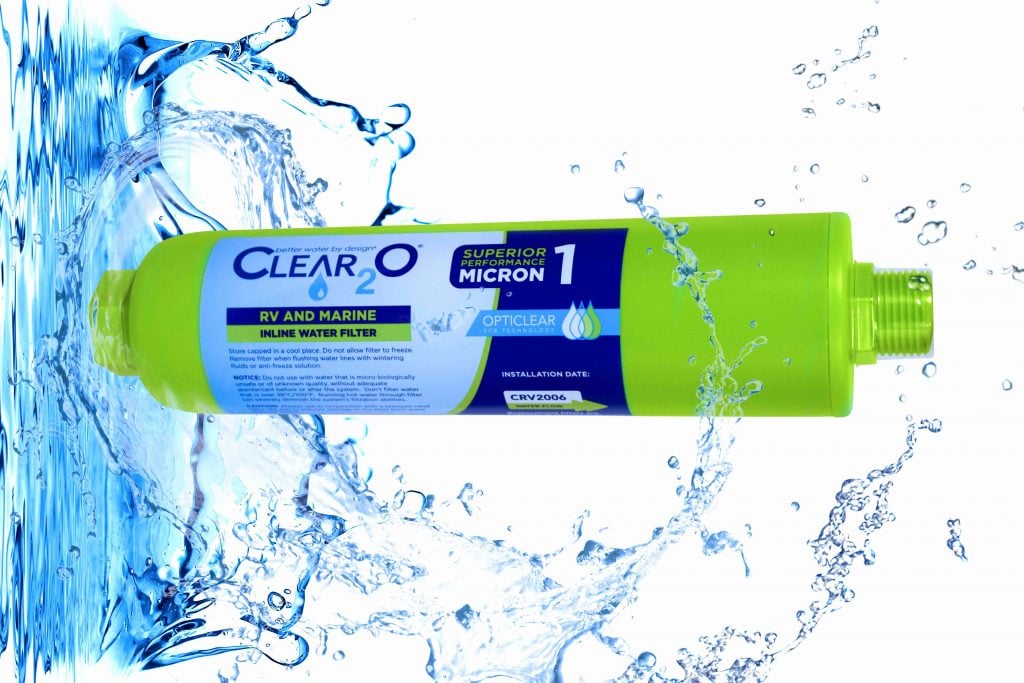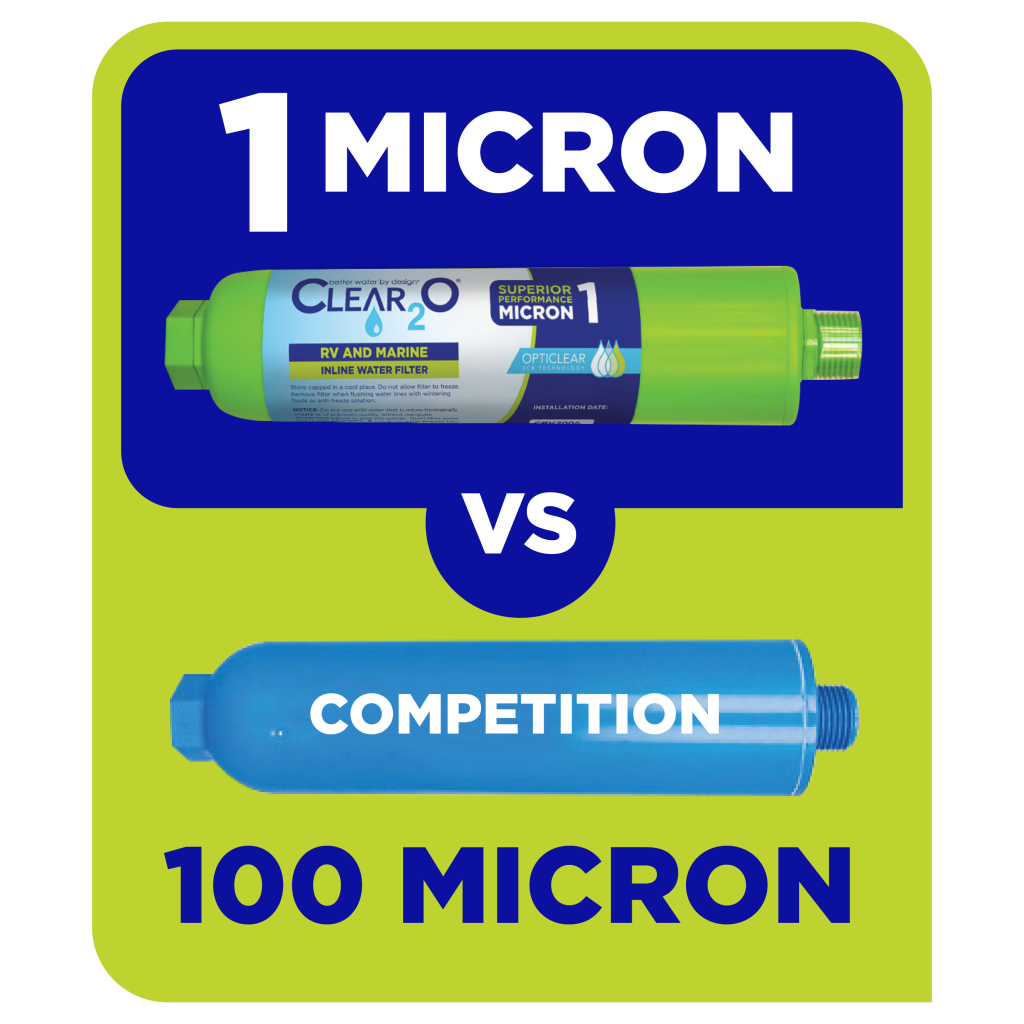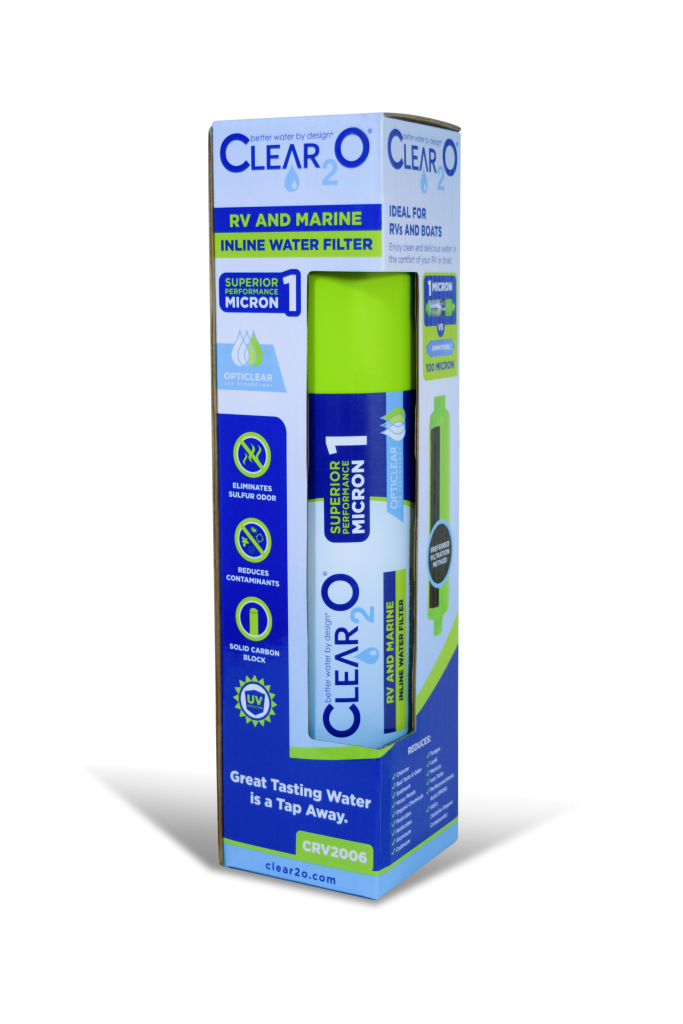Sponsored by Clear2O

- The CLEAR2O green water filter with solid carbon block
CLEAR2O® RV Water Filter Versus the Camco Water Filter
Let’s face it, as RVers, we can be lazy. Whether it’s a tire pressure monitor, air conditioning enhancement, or a water filter, we simply choose the brand that makes the most noise.
In recent times, air and water filtration have moved front and center. We all now know what N95 means as it pertains to masks, but do we know what solid carbon block means as it pertains to water filters?
The difference between green and blue is a solid carbon block
We can simplify the conversation by making it a comparison between two well-known brands: the blue Camco water filter, and the green CLEAR2O® water filter. Through marketing and familiarity, RVers have to come to know the popular blue water filter. There has been no need to understand the real science behind it or even how well it works because “everybody” has one.
Suddenly, that need has changed. Pandemic protocols have opened our eyes to all types of filtering, not just air filtering. Now, understanding the difference between loose carbon and a solid carbon block is important. Knowing the difference between 1-micron filtration and 100-micron filtration is a big deal. We need to understand water filtration better.
The solid carbon block difference
Put quite simply, a solid carbon block is just that, a solid block of carbon that water must pass through. CLEAR2O uses this in their water filters, versus loose carbon found in other brands.
To understand this, think of sifting sand through a square sheet of cotton, versus a handful of loose cotton balls. Which one do you think will be more effective?
I’m OK with drinking hair
If that description fits you, read no further. However, if allowing debris the size of and including a human hair into your water system bothers you, it’s time you switched from your 100-micron filter to the 1-micron solid carbon block filter used by CLEAR2O.
When we start talking about microns, it’s easy to get lost in the science and gloss over it. Simply put, if you want to block out disgusting elements from your water supply, you need 1-micron.
Is campground water safe to drink?
Water from campground faucets can be a concern. Even if the local city has correct water treatment measures in place, there is no guarantee that the pipes and faucets in the campground have been properly maintained.
Seasonal sites often sit unused for months, leaving stagnant water to settle in the pipes or faucets. If not properly flushed in the spring, your water filter takes the brunt of that settled debris if you are that site’s first customer.
People in rural areas often say, “you get used to the water here.” While this may be true, and the water may not be harmful, how bad does it taste or smell that you have to get used to it?
I use a great filter, but I have to change it so frequently!
So you took the leap and purchased a high-quality, and yes, more expensive, water filter for your RV. You are finding that it clogs and you have to change it more frequently. Yes! Point proven…your filter is actually working. It’s blocking the stuff you don’t want to drink.
For the part-time RVer, buying a new RV water filter every season might be needed. For the full-time RVer, you probably should look into a secondary sediment filter that is washable and reusable to catch the big particles before it hits your solid carbon block water filter.
The CLEAR2O DirtGUARD filter is a great choice. You can read more about this clever add-on in this article on Camper Report.
A great plastic water bottle alternative
Whether you are looking to give the environment a break or simply don’t have enough room for all the plastic water bottles you might need for your journey, using high-quality RV water filters is a great alternative. Water that is properly filtered into a properly sanitized RV freshwater tank is safe to drink, and a great way to cut down on the number of plastic bottles you use.
RVs with a whole-house filtration system will filter that water a second time, and if you have an RV with a residential fridge with a water dispenser, it gets filtered a third time! It all starts with a high-quality water filter that is cleaning the water on the way in.
Conclusion on the Solid Carbon Block RV Water Filter
In the battle for green versus blue, green wins every time. Start using a solid carbon block water filter, like those from CLEAR2O. Protect your health and your RV’s water systems by introducing clean water into your RV from the start.
A solid carbon block water filter with 1-micron filtering is the right way to be safe in these times going forward. CLEAR2O filter products, including DirtGUARD, are available online from Amazon, Walmart, and Camping World. Visit CLEAR2O’s website for more information.



So the winner of your competition is the same company that sponsored the page?? Right, I don’t by anything that says Camco, learned that mistake years ago, but there are a lot of better ways to filter your water.
This is obviously an ad masquerading as a news article. No mention of the cost factor. No mention of durability. And misinformation is presented as facts. I am less likely to buy one of the green filters after reading this article.
The green filter clogs up and lowers the water pressure FAST. We’re on our third now since using clr2o and they have each not lasted more than three weeks. We also use the green dirt guard which is NOT the problem. With a $34.00 cost for the filter, it is NOT worth it; and in fact, rediculous!
You can also buy a G.E. whole house filter canister at Home Depot and put on hose adapters (I added quick connects also). Then you only have to buy carbon/particulate filter cartridges 2-packs every other year for $10. I use a fresh cartridge in the spring/summer/fall for the camper when camping, then use that cartridge in my koi pond all winter when our irrigation water isn’t available and I have to use city (chlorinated water).
I agree to your comment. Next it will be Purple & Orange. We all know what works and what don’t work. I’m sticking with Blue.
We also went with GE canisters in series. Quick connects and adapted a cooler since it sets outside the camper. Change cartridges every 3 months.
My wife and I installed the CLR20 filter but with a little mod for our Class A. We installed a bar sink faucet in the kitchen for drinking and cooking. with a few fittings and basic plumbing skills with some PEX the 1 micron filter is in line of the bar faucet. The 20 micron canister attaches to out water supply hose and feeds through a factory installed 5 micron canister filter for the filling of out on board tank. The 1 micron filter lasts for approx. 3 months for our drinking, coffee and cooking. The combination of the CLR2O 20 micron and 5 micron filters live in our water bay and supply shower, kitchen sink, washing machine and toilet supply with no problems.
We’ve used an 0.5 micron solid carbon block filter since we started full-timing in April 2014. We use a 10-micron filter from Camping World to protect the drinking-water filter from clogging quickly. What in all of this justifies an article restricted to two filters identified by the enclosing color?
Another ‘scare them into buying the newest gadget’ article.
The ‘ get a dense filter to remove everything’ is the wrong idea and is why this ‘great new thing’ wasn’t available before. Know what you are removing, why and how. Use progressively finer filters to be able to prevent course debris (cheap filters) from cloging up your expensive, finer filters. That is what the blue filter is and all it needs to be, a coarse filter.
A carbon filter on an input to your water tank is a bad idea. Chlorine or chloramine is put into the water by municipal water suppliers to disinfect the water and keep water systems free of biological contaminants. Carbon filters remove them, leaving your RV’s water tank to become a breeding ground.
I find that water pressure in RV parks is notoriously low. Does a 1 micron filter constrict power pressure, making it even lower?
How much did they pay you for this advertisement?
Well you’ve proved one thing. You’ll say anything you are paid to. I worked 35 years in the design and construction of Water Treatment Plants. Activated Carbon is the correct term. And it works by trapping pollutants on it’s exterior crevices, not by water going through it. So, more pieces provides more surface area. Hence more filtration of pollutants.
AKA – Solid is worse by definition.
Since we have a built-in filter system on the incoming water line, our entire water system in our RV is filtered. This means sinks and shower too. So flow rate is very important to us. We tried an advanced filter and the flow rate was MUCH slower than the standard filter, which adversely affects the shower. This is a consideration for many RVers and this information should have been mentioned in the article
Like so many posts on this site, I take this to be a sales pitch for a product. I would like to see some specific results of testing, rather than “this is better than what you are using,” with not data to back it up.
Thanks for the article. I recently purchased both the Clear20 Dirtguard sediment filter and their inline filter for our Class-A motorhome. While the sediment filter can be disassembled for inspection and cleaning, the inline filter (whether green or blue) cannot, which begs the question, how do you know when it needs to be replaced?
Do I want to filter out the chlorine early in the stream or leave it in until closer to the point of use, especially if I use the fresh water tank for everything?
When the water starts tasting or looking bad the filter is worn out. It’s GAC has captured it’s limit of pollutants. The taste is because the pollutants are just going though the filter instead of being trapped in it.
When your green 20 micron (large canister housing) is dirty water can still flow through. When the green 1 micron filter is getting full of contaminants, the flow of water will be reduced or stopped. The smaller green filter can easily be removed and replaced and you are back in business. Frequency of replacement is dependent on quality of water supply you attach your hose to.
Huge error in this article. A solid carbon block would not allow water to pass. It is a microporous carbon block. Users should try a PUR Faucet Mount filter. The one click mounting can be removed during travel.
Singed, a former carbon block filter engineer.
What was your experience in water flow? A lot of reviews seemed to suggest that the flow dropped significantly
Thank you for explaining the differences! I will convert to green! And hopefully use less plastic to carry water!
Seems more like personal opinion, marketing or advertising as opposed to a CONSUMER REPORTS or scientific type of testing.
Hello,
If the carbon block is removing all of the chlorine in the water. Is there a chance of pathogens growing if it sits for a few weeks between trips?
Wow – pretty good advertisement for Clear20 masquerading as an objective article about filters.
More a pretty good argument against rvlife.com – if this is what is published as an article. . .
It doesn’t help that the Clear20 rv filter products are constantly sold out and unavailable.
Very missleading article the camco filter is 20 microns not 100 you must be sponsored by the green one.
Bottled Water
Once slight omission is the country of origin. The green unit is made in China, the blue unit is from the USA. My personal preference when it comes to water related products is to stick with US made items. Secondly, the greater the filtration, the less water flow when it comes to a hose filter unit. This review was as unbiased of a biased advertisement if I’ve ever read one.
Camco filters are made in the US. CLEAR20 filters are made in China. That’s all I need to know.
Don’t buy “made in China” – regardless!
We don’t full-time. Usually several long weekends or more.
We use the blue for everything but drinking, cooking, coffee.
We run our well water through our Big Berkey at home and take several gallons with us.
We have tried and tried to use the green filter as well as the Dirt Guard. Always restricts our water pressure to the point of frustration. We have bought new green filters and even cut one open to look at it. It seems to us there is just typically not enough pressure to push the water through all this. Very frustrating.
I love the Waterdrop water sludge! I just moved by and the water in then stinks and tastes awful. This filtration system removes the odor and the water tastes great. Installation took lower than 30 twinkles with the connectors. I really did not suppose it would fit under the Gomorrah, but the slim sludge casing fits neatly coming to my Gomorrah.